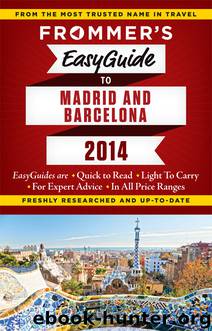Frommer's EasyGuide to Madrid and Barcelona 2014 by Patricia Harris

Author:Patricia Harris [Harris, Patricia; David, Lyon]
Language: eng
Format: epub
ISBN: 9781628870343
Publisher: FrommerMedia
SEGOVIA
Poor Segovia! Because the city’s Roman aqueduct appears on every checklist of Spanish monuments, the city often suffers from drive-by tourism. It’s easy to park near the aqueduct, take a picture, maybe stop for lunch, and then move on. But Segovia is more than just a pretty face. Outside the perimeter of its old walls lie important religious communities and a mystical shrine of the Knights Templar. In the city proper, Segovia displays a monumental drama from the arches of its Roman aqueduct on one end to the fantasy castle of its Alcázar on the other. The city is built on a large rocky outcrop, resulting in narrow, winding streets that have to be covered on foot to visit the Romanesque churches, early Renaissance palaces, and medieval Judería. This ancient city is located at the heart of the castle-rich part of Castilla. Isabel herself was proclaimed queen of Castilla here in 1474.
Essentials
GETTING THERESeventeen trains leave Madrid every day. Five take over 2 hours to reach Segovia, but the high-speed trains arrive in 26-29 minutes. The five slow commuter trains leave from Chamartín station; a one-way fare is 7.50€. The high-speed trains leave from Atocha station and cost 12.50€ (for the AVANT) to 24.10€ (for the AVE or the ALVIA). The traditional rail station at Segovia is on Paseo Obispo Quesada s/n (www.renfe.com; 90-232-03-20). It’s a 20-minute walk southeast of the town center but you can take bus no. 3 (1€), departing every quarter-hour for the Plaza Mayor. The high-speed train arrives at Segovia-Guiomar, 4km (2½ miles) from downtown but served every 15 minutes by bus no. 11 (1€) to the aqueduct.
Buses arrive and depart from Estacionamiento Municipal de Autobuses, Paseo de Ezequiel González 10 ( 92-142-77-06), near the corner of Avenida Fernández Ladreda and the steeply sloping Paseo Conde de Sepúlveda. It’s about a 7-minute walk to the aqueduct. There are 20 to 35 buses a day to and from Madrid (which depart from Paseo de la Florida, 11; Metro: Norte), and about four a day traveling between Ávila and Segovia. One-way tickets from Madrid cost 8€.
If you’re driving, take the N-VI (on some maps it’s known as the A-6), in the direction of A Coruña, northwest from Madrid, toward León and Lugo. At the junction with Rte. 110 (signposted SEGOVIA), turn northeast (AP-61 or N-603).
VISITOR INFORMATIONThe Visitor Reception Center, Plaza del Azoguejo, 1 (www.segoviaturismo.es; 92-146-67-20), is open daily 10am to 8pm and offers a free city map and sightseeing advice. It’s a good place to start if you arrive at the Roman aqueduct. Follow calle Juan Bravo toward Plaza Mayor where you’ll find the Tourist Information of Castilla y León, Plaza Mayor, 10 (www.turismocastillayleon.com; 92-146-03-34), which is open daily from 9am to 3pm and from 5 to 7pm. This regional office’s city map is easier to use. If you’re going to visit Ávila, ask for that city’s map as well.
Where to Stay
Hostería Ayala BerganzaWhether you select a room in the 15th-century former noble home or in the modern addition, you will find a feeling of ease and retreat from the modern city.
Download
This site does not store any files on its server. We only index and link to content provided by other sites. Please contact the content providers to delete copyright contents if any and email us, we'll remove relevant links or contents immediately.
Spell It Out by David Crystal(35348)
Underground: A Human History of the Worlds Beneath Our Feet by Will Hunt(11261)
A Year in the Merde by Stephen Clarke(4657)
Venice by Jan Morris(2051)
Claridge's: The Cookbook by Nail Martyn & Erickson Meredith(1963)
My Paris Kitchen: Recipes and Stories by Lebovitz David(1893)
A TIME OF GIFTS by Patrick Leigh Fermor(1849)
The Plantagenets by Dan Jones(1617)
Welcome to the Goddamn Ice Cube by Blair Braverman(1601)
Bang Poland: How To Make Love With Polish Girls In Poland by Roosh V(1588)
Top 10 Prague (EYEWITNESS TOP 10 TRAVEL GUIDES) by DK(1569)
From Russia with Lunch by David Smiedt(1551)
The Finnish Way by Katja Pantzar(1536)
The Isle of Mull by Terry Marsh(1519)
A TIME TO KEEP SILENCE by Patrick Leigh Fermor(1499)
Rick Steves London 2018 by Rick Steves & Gene Openshaw(1494)
A Taste of Paris by David Downie(1491)
Merde in Europe by Stephen Clarke(1436)
Insight Guides Experience Tokyo by Insight Guides(1419)
